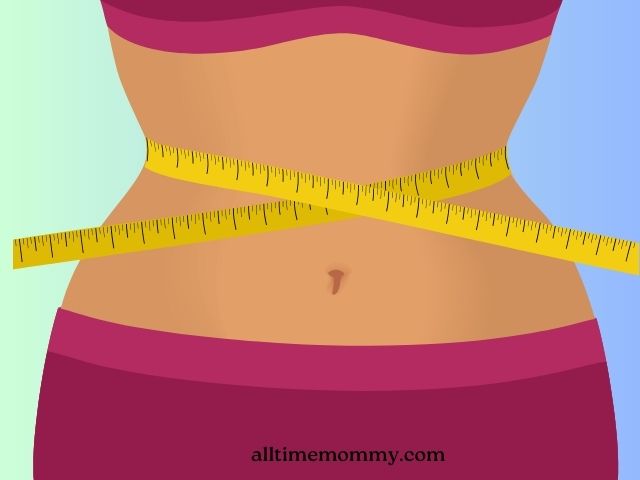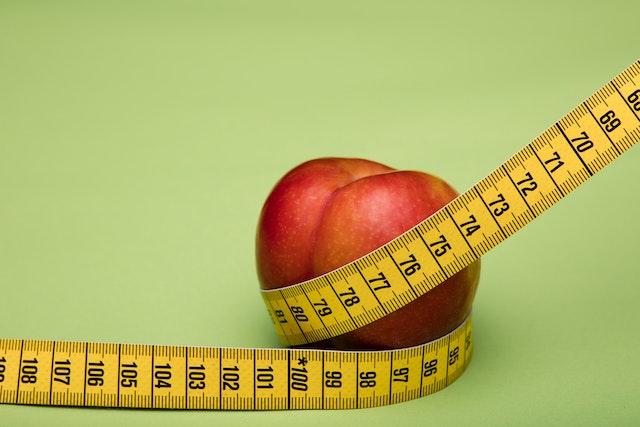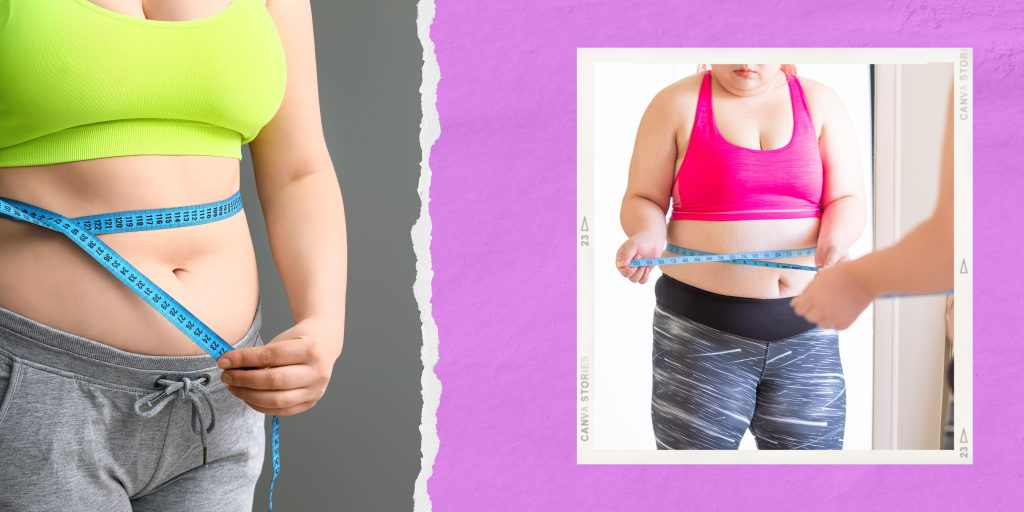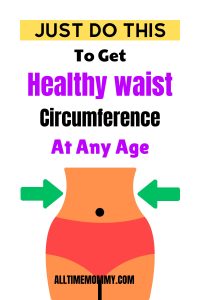Here is what your Waist size says about your health. Learn why waist size is so important as you age and how you can reduce your waist circumference to stay healthy and fit. Start taking care of yourself today.
During the teenage years, many women are bothered with their waist only because it affects their appearance.
But as you age and probably become a mother, appearance, and body shape may no longer be a priority.
As such, you tend to sit, relax and enjoy.
But do you know even in your middle and sunset years, you still must care about the size of your waist circumference?
Yes, mama,
Your waist size speaks volumes about the fat around your middle. A larger waist may mean excess fat inside your organs.
And that is not healthy.
In fact, one study suggests that a larger waist circumference may increase your risk of developing potential non-communicable diseases.
This non-communicable disease will result from increased fat levels around your crucial organs like the kidneys, liver, and pancreas.
The buildup of these fats is linked to lifestyle diseases like high blood pressure, heart disease, stroke, and type-2 diabetes.
Plus,
I recently learned from Dr. Kinjui when attending a women’s conference that this fat might increase your risk of having fibroids.
So,
What Does Your Waist Size Say About Your Health?
Measuring the waistline can help to assess obesity-related health risks.
Your waist size is a mirror that uncovers the hidden excess fats around your organs waiting to cause lifestyle diseases.
And the frustrating part;
Even with a healthy overall body weight, you may still have excess fat around your waist.
So,
How Do You Know Whether Your Waist Size Is Okay?
First, learn to measure your waist even if you have no intention of modelling.
How to measure waist size
- Stand straight and place your tape measure below your ribs and the top of your hips. Your core is at the middle point, halfway between the ribs and hips or just above the belly button.
- Record the measurement.
Interpretation;
For Men, waist size is interpreted as follows:
- Below 94cm (37in) -low risk.
- 94–102cm (37-40in) – high risk.
- Above 102cm (40in) – very high.
For women, a waist size
- Below 80cm (31.5in) – low risk.
- 80–88cm (31.5-34.6in) – a high risk
- Above 88cm (34.6in) – very high.
Waist-to-Hip Ratio
Another core factor you must be concerned with in regard to your waist size is your WHR.
Most people tend to confuse WHR and BMI. Body mass index (BMI) calculates the ratio of your weight to your height.
The waist-to-hip ratio measures the ratio of your waist circumference to your hip circumference.
Sometimes your BMI may be within a moderate range, yet you still have a high risk of suffering from non-communicable disease.
Why?
Because you’re carrying a significant amount of your weight around the midsection, which is unhealthy.
One study suggests that increased WHR may be a better indicator than BMI for predicting the risks of cardiovascular disease, premature death, and complications in trauma patients.
You may assume an apple-shaped body if you carry more weight around your midsection. And this may put you at a higher risk of heart disease and type 2 diabetes.
Some studies also cite the danger of having a higher possibility of premature death in apple-shaped bodies than in people with more weight in their hips (a pear-shaped body).
How do you calculate your Waist -Hip Ratio?
You can figure out your WHR independently or consult your professional healthcare provider.
To measure your waist-to-hip ratio
- Get your waist circumference by measuring the smallest part of your waist. This is the part just above your belly button.
- Then measure the distance around the widest part of your hips or buttocks. This is your hip circumference.
- You can calculate your WHR by dividing your waist and hip circumference.
According to the WHO chart:
A Low WHR is:
- 0.95 or less in men
- 0.80 or less for women
A Moderate WHR is:
- 0.96 to 1 in men
- 0.81 -0.85 in women
A High WHR is:
- 1 or more men
- 0.86 or more in women
Then there is also another one;
Waist-to-Height Ratio
Your waist-to-height ratio identifies your cardiometabolic risk and is calculated by dividing the waist circumference (WC) by height.
According to this study, your (WHtR) should be less than half your height.
For example, if you’re 170 cm (5 ft 6 in) tall, a healthy waist circumference should be about 68 cm (26.8 in) and 83.3 cm (32.8 in).
WHtR considers both height and central obesity.
WHtR is similar to BMI and WC but may be preferred because it’s not sex- and age-dependent
How do you calculate waist–to–height ratio?
Take your waist measurement, then divide it by height measurement, W / H, in centimetres.
For example, if you have a 28 in (71 cm) waist and 5 ft 6 in (170 cm) height, it has a core–height ratio of 0.42.
What is an excellent waist-to-height ratio?
Generally, a waist-to-height ratio between 0.4 and 0.49 is considered healthy.
It may suggest that you’re underweight if it’s below 0.4. On the other hand, values exceeding 0.5 indicate a greater probability of health issues related to excess body weight.
Related:
What Causes an Increased Waist Size?
There are many causes of a High Waist Circumference
An apple’s waist size may result from intra-abdominal visceral fat. Visceral fat develops between and around internal organs.
Research suggests that excess intra-abdominal fats may accumulate due to sex hormones, local cortisol production in abdominal adipose tissues, growth hormones, and dietary fructose.
This type of fat differs from “regular” fat, which sits just beneath the skin where you can even pinch it.
According to a publication in the Centre for Disease Control and Prevention, factors affecting waist circumference in adults may include;
- Poor diet
- low levels of physical activity
- high levels of sedentary activities
- Genetic issues like your body shape and how your body stores visceral fat.
- Age
- Hormonal changes
9 Tips To Get Healthy Waist Circumference For Women
1. Eat More Lean Proteins
One study shows that high-quality proteins may help you lose abdominal fat.
Proteins can improve your satiety and decrease your fat mass.
Eating a high protein-rich diet may help increase appetite-regulating hormones (GIP, GLP-1), which increases your satiety.
This will make you eat less and feel full for longer hours.
Additionally, eating proteins may reduce the levels of your hunger hormone, scientifically known as orexigenic hormone secretion (ghrelin).
It can also increase the thermic effect of food and improve glucose homeostasis.
Eating lean proteins can help in weight management by reducing the number of calories you take and increasing the number of calories you burn.
According to a study, increasing your dietary protein from 15% to 30% of energy can help your weight loss journey without intentionally restricting your daily calories, portions, fat, or carbs.
2. Get More of Your Carbohydrates from Fruits and Vegetables
According to a study in the American Journal of clinical nutrition that sought to establish how macronutrient intake affected waist circumference, researchers concluded that taking carbs from fruits and vegetables was inversely associated with waist circumference and was significantly different from any other carbohydrate.
Be sure to eat complex carbs rich in feel-full fiber.
Fill your plates with whole Fruits, Vegetables, whole grains, and oatmeal to help cut down belly fat.
Related:
7 Simple Hacks To Stop Sugar Cravings For Good
3. Take Probiotics
One study suggests that your gut microbiota composition may be closely related to obesity.
Probiotics with certain bacteria from the Lactobacillus family have been found to reduce the number of calories you absorb from food.
These bacteria are thought to release appetite-reducing hormones, which help you burn more calories and fats.
Additionally, these strains Increase levels of fat-regulating proteins like angiopoietin-like 4 (ANGPTL4), Which decreases fat storage.
If your obesity results from body inflammation; taking probiotics may be all you need. Probiotics will improve your gut lining and reduce inflammation and metabolic disorders that may increase the risk of obesity.
Above all
Research has found that eating food with Lactobacillus Strains for about 6 weeks Can reduce body fat by 3–4%.
Best strains for weight lose
- Lactobacillus fermentum
- Lactobacillus rhamnosus
- Lactobacillus amylovorus
- Lactobacillus gasseri
- Bifidobacterium lactisB-420
Related:
Probiotics For Weight Loss: How Do Probiotics Help You Lose Weight and Belly Fats?
4. Drink Green Tea
Green tea may significantly lower the amounts of the midsection and belly fat and here is the reason.
Several studies suggest that green tea contains catechins compounds which can reduce harmful visceral fat.
Another study involving Chinese adults with high abdominal visceral fat levels shows that consuming catechin-enriched green tea beverages for about 12 weeks can help reduce visceral fat loss.
Also, another animal study shows that green tea’s active compounds help to boost the effects of fat-burning hormones in your body.
As such, they enable and speed up the process by which your body breaks down fat cells before being burned.
5. Snack on Nuts and Seeds
Snacking on healthy nuts and seeds can help reduce hunger and regulate the amount of calorie intake.
Some nuts can also have appetite-suppressing effects.
This is because nuts increase the production of appetite-regulating hormones, peptide YY (PYY), and cholecystokinin (CCK).
Snacking on nuts like pistachios, Brazil nuts, walnuts,and almonds can help your body fight inflammation and keep your heart healthy.
Additionally, nuts can boost the rate at which your body burns calories.
According to research involving 29 participants, eating a meal containing walnuts can boost calorie burning by up to 28% more.
So if you’re thinking about ways to reduce your waist circumference, snack more on nuts and healthy seeds.
Lifestyle Adjustments
6. Learn to Manage Your Stress
Persistent stress and anxiety may lead to increased production of cortisol.
A study shows stress and cortisol reactivity can influence central fat distribution.
How?
Because the increase in cortisol production significantly increases visceral fat storage.
To be safe, try to work on your stress levels.
You can manage your stress by engaging in meditation, yoga, and physical exercise.
7. Intermittent Fasting
Intermittent fasting is simply an eating pattern that alternates between periods of eating and fasting.
Intermittent fasting is not dieting.
As such, It does not restrict any foods but rather focuses on timing.
One scientific review suggests engaging in intermittent fasting for about 6-24 weeks may help reduce visceral fat by 4–7%.
8. Have a Night of Adequate Sleep
Having an adequate night’s sleep is crucial for your waist circumference.
One study that included 293 participants suggest increasing sleep from 6 hours or less to about 7–8 hours can reduce visceral fat gain by roughly 26%.
More research has associated short sleep duration with increased central obesity in women.
So,
If you aim to lose these stubborn fats, consider adding more hours to your sleep.
Physical Activities
9. Do More Aerobics Exercises
According to a study, aerobic exercise can help you lose visceral fat.
Yes, mama.
Aim at doing moderate to high-intensity aerobic exercises consistently.
As mentioned above, combining aerobics with a healthy diet will significantly reduce your visceral fat.
The best aerobic exercises include running, brisk walking, rope skipping, and jogging at least two to three times per week.
Other exercises for a smaller waist may include
- Bicycle crunch
- Russian twist
- Plank
- Side plank
10. Foods to Avoid for a Slim Waist size
- Trans fat oil
In a study conducted on monkeys, regular consumption of trans fat oil can make you gain about 33% more visceral fat.
Transfat is an artificial type of fat that is added to vegetable oils to give them a long shelf life.
- Added or simple sugar.
Added sugar is rich in simple sugars like fructose, which is easily metabolized and turned into fats by the liver.
As such, consuming more added sugar daily increases visceral fat storage.
If you plan to lose belly fat, you must do away with sugar-sweetened products.
These products include sodas, juices, and sweet teas.
Also, Consuming simple sugars increases your hunger levels. This will push you to eat more calories than you actually need.
- Refined carbohydrates
Refined carbs that include processed sugars and refined grains are thought to increase the risk of obesity.
Eating Refined carbs consisting of little to no fiber or essential vitamins for your body is only a highway to increasing your waist circumference.
These foods are fast to digest, thus may encourage rapid spikes in blood sugar increase your hunger level and make you ingest more calories.
- Limit your alcohol intake.
Too much alcohol may be harmful to your waistline. Studies show that drinking too much or moderate alcohol may lead to more visceral fat storage.
To be safe, do away with alcohol, or if you must drink red wine in moderation may be your best option.
Related:
10 Warning Signs That You’re Eating Too Much Sugar
Takeaway
As you age, paying closer attention to your waist circumference is important. Learn why you should keep an eye on this important measurement and how it affects your health over time.
Get up-to-date information and an understanding of the risks associated with increased waist circumference.
UP NEXT:
- Redefine Your Class: 12 Key Things That Will Transform You Into a Classy Woman
- How To Quickly Ellevate Vaginal Itching Before Periods
- This is All You Need To Know About Seed Cycling For Hormonial Balance
- Probiotics for Women: 11 Health Benefits of Taking a Probiotic Once In a While.
DISCLAIMER The information contained in this post is for general information purposes only. I’m not a health practitioner and as such, this information should not be used as a substitute for consultation with your professional service provider.





